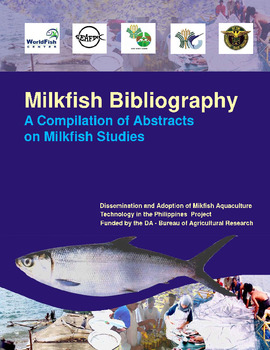Bacterial flora of milkfish, Chanos chanos, eggs and larvae
- Global styles
- MLA
- Vancouver
- Elsevier - Harvard
- APA
- Help

URL ที่เชื่อมโยง
www.jstage.jst.go.jpวันที่
1996Page views
4,311ASFA keyword
AGROVOC keyword
Taxonomic term
เมตาดาต้า
แสดงระเบียนรายการเต็ม
Share
นามธรรม
Aerobic bacterial flora of eggs and larvae of milkfish, Chanos chanos, was investigated. Microflora in the incubating water of egg, rearing water of larvae, water source, and larval food was also analyzed.
Aerobic bacterial flora of milkfish eggs was largely influenced by the bacterial flora in the incubating water. Both in eggs and in the incubating water Pseudomonas species were the dominant bacteria. During milkfish larval rearing, intestinal aerobic bacterial flora was examined at days 1, 3, 7, 10, 15, 18, and 21. Bacterial number in the larvae and rearing water significantly increased during the culture period up to day 18 but dropped significant at day 21. Pseudomonas species were detected from yolk-sac larvae (day 1) as the dominant bacteria, similarly to the normal flora in the rearing water. However, intestinal bacteria were predominated with Vibrio species when the yolk-sac was absorbed on day 3. Larval rearing water, water source, and larval food contained predominantly Pseudomonas species.
การอ้างอิง
Fernandez, R. D., Tendencia, E., Leaño, E. M., & Duray, M. N. (1996). Bacterial flora of milkfish, Chanos chanos, eggs and larvae. Fish Pathology , 31(3), 123-128. http://hdl.handle.net/10862/1508
Type
ArticleISSN
0388-788Xคอลเลกชัน
- Journal Articles [1258]
Related items
Showing items related by title, author, creator and subject.
-
Milkfish bibliography: a compilation of abstracts on milkfish studies
WorldFish Center (WorldFish Center, 2007)Milkfish Bibliography covers 700 references on milkfish biology; broodstock management and fry, fingerling and egg collection and production; milkfish culture systems; health and nutrition; post harvest technology; ... -
Ongoing research studies on maturation and spawning of milkfish, Chanos chanos at the brackishwater shrimp and milkfish culture applied research and training project, Jepara, Indonesia
Alikunhi, K. H. (Aquaculture Department, Southeast Asian Fisheries Development Center, 1976)The paper gives an account of the research work carried out at Jepara, Indonesia, on induction of maturity of milkfish in ponds and enclosures, and procurement of the spawners from the wild for seed production by hypophysation. ... -
Ration reduction, integrated multitrophic aquaculture (milkfish-seaweed-sea cucumber) and value-added products to improve incomes and reduce the ecological footprint of milkfish culture in the Philippines
de Jesus-Ayson, Evelyn Grace T.; Borski, Russel J. (AquaFish Collaborative Research Support Program, Oregon State University, 2012)In the Philippines, cage culture of milkfish in marine environments is increasing. The practice uses high stocking densities, with significantly greater inputs of artificial feeds which more often than not, have led to ...






